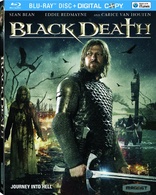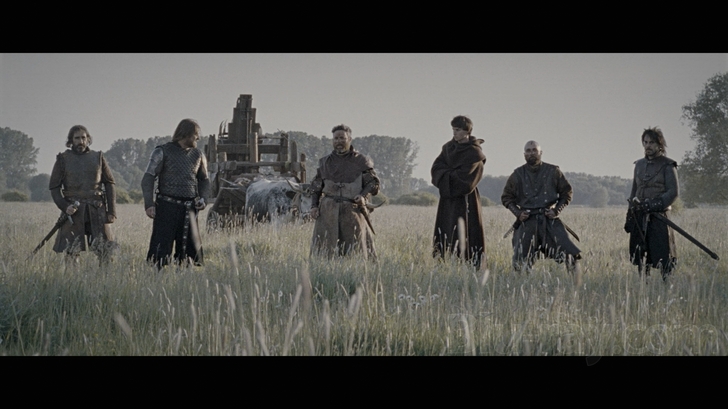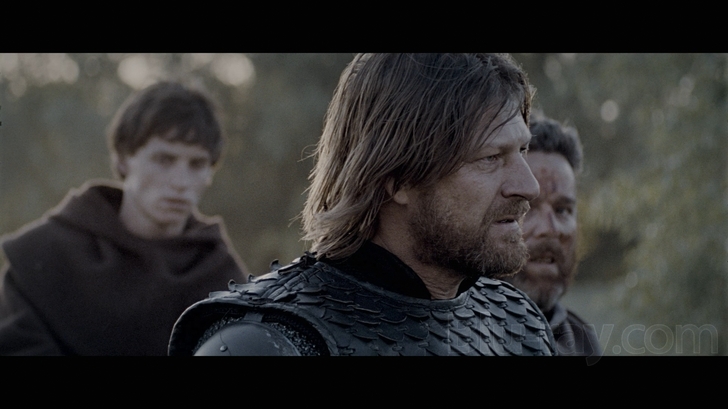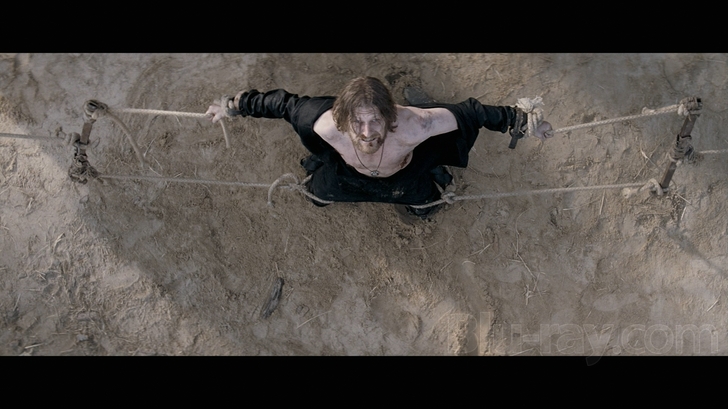Black Death Blu-ray Movie
HomeBlack Death Blu-ray Movie 
Blu-ray + Digital CopyMagnolia Pictures | 2010 | 102 min | Rated R | May 10, 2011

Movie rating
6.7 | / 10 |
Blu-ray rating
| Users | 3.7 | |
| Reviewer | 3.0 | |
| Overall | 3.4 |
Overview
Black Death (2010)
Set during the time of the first outbreak of bubonic plague in England, a young monk is tasked with learning the truth about reports of people being brought back to life in a small village.
Starring: Sean Bean, Eddie Redmayne, John Lynch (I), Tim McInnerny, Kimberley NixonDirector: Christopher Smith (VIII)
| History | Uncertain |
| Mystery | Uncertain |
| Drama | Uncertain |
| Adventure | Uncertain |
Specifications
Video
Video codec: MPEG-4 AVC
Video resolution: 1080p
Aspect ratio: 2.35:1
Original aspect ratio: 2.39:1
Audio
English: DTS-HD Master Audio 5.1
Subtitles
English SDH, Spanish
Discs
50GB Blu-ray Disc
Single disc (1 BD)
Digital copy (as download)
BD-Live
Packaging
Slipcover in original pressing
Playback
Region A (locked)
Review
Rating summary
| Movie | 3.0 | |
| Video | 4.0 | |
| Audio | 4.0 | |
| Extras | 2.0 | |
| Overall | 3.0 |
Black Death Blu-ray Movie Review
A pop Seventh Seal.
Reviewed by Casey Broadwater May 11, 2011Whether he’s in the Middle Ages, Middle Earth, or the middle of colonial India, Sheffield-born actor Sean Bean seems at home donning armor, toting a massive length of sharpened steel, and leading grimy men into battle. With a face that appears to have been chiseled out of granite with a pickax, he looks both noble and rough, qualities that have netted him numerous roles as a warrior with convictions, from the titular Sharpe in the long- running British TV films and his turn as Boromir in The Lord of the Rings, to his most recent gig as the “Warden of the North” in HBO’s new fantasy series Game of Thrones. You might call Bean the thinking man’s sword-swinger. He’s at it again in Black Death, a 14th century plague thriller from director Christopher Smith, whose previous credits include the horror films Creep, Severance, and Triangle. Black Death has some horror elements as well—how could it not?—but this is surprisingly more of a medieval men-on-a- mission film, about a squadron of Christian soldiers sent to investigate reports of necromancy in a town conspicuously free of disease. It’s dour and cynical, but the film is mysterious and violent enough to keep us interested until its anti-religion conclusion.

Sean Bean features prominently in promotional materials for the film, but the real protagonist is The Other Boleyn Girl actor—and Burberry model—Eddie Redmayne, who plays Osmund, a young monk-in-training in a 14th century town plagued by, well, the plague. Osmund is devout, but he plays fast and loose with his vows when he falls in love with Averill (Kimberley Nixon), a willowy lass who’s been taking shelter inside the monastery. Fearing for her health, Osmund sends Averill out into the rural marshlands, where she promises to wait for him, but he’s conflicted on his own fate—should he remain a cloistered holy man, or should he serve God out in the world, alongside his true love? No sooner does he shoot off a heavenward prayer, asking for guidance, than firebrand knight Ulric (Bean) shows up at the church with his cadre of religious mercenaries, looking for a guide who can take them to a remote village in the aforementioned marsh, where a necromancer is supposedly plying the dark arts. Ding, ding, ding! It’s a sign!
Osmund heads out with this rough ‘n’ tumble lot, comprised of your usual assortment of cutthroats, rapists, and torturers, all of them semi- reformed zealots. Besides Sean Bean’s Ulric, who believes God has called him to kill pagans and thus rid the land of the plague, none of the other men make much of a narrative impact. They’re fodder, basically, for the bloodletting to come, and they’re mostly forgettable, except for one guy who looks exactly— exactly!—like Klaus Kinski in Werner Herzog’s conquistador adventure, Aguirre: The Wrath of God. The resemblance is so uncanny that it has to be intentional.
Anyway, the journey to the marsh is fraught with peril, monstrosity, and plenty of imagery borrowed from The Seventh Seal. Penitent fanatics flagellate themselves with whips, a mob of angry peasants prepares to burn a suspected witch, and Osmund, hoping to reunite with Averill, finds only a pile of bloody clothes in the place where they had agreed to meet. He’s devastated, but we know better—this is a film about a necromancer, after all, so the presumed dead probably won’t be dead for long. There’s a great skirmish scene here too, as Ulric and his men cross swords with some roving bandits in the woods.
This “road movie” phase of the film morphs into something closer to The Wicker Man when the mercenaries arrive at the village, where the church looks conspicuously disused and the plague is nowhere to be seen. The inhabitants greet them warily, and the village’s female leader, the flaxen-haired Langiva (Carice van Houten), throws a feast for the travelers, but snorts in muted derision when Ulric offers to say grace over the meal. Clearly, something’s up. It’s no spoiler to reveal that Langiva is the devil-consorting priestess that Ulric’s been after, and the remainder of the film becomes a battle of the faiths where both sides are clearly in the wrong. Superstition leads the Christians—who have no scientific knowledge of how sickness actually spreads—to brutally torture and murder in God’s name. And the pagan peasants are just as ignorant, buying into Langiva’s mumbo-jumbo powers and following her every violent order. “People need miracles,” she says, “and they worship the miracle makers, whoever they might be.” This might as well be the film’s misanthropic thesis—an assertion that all believers are easily duped herd-followers and all miracle makers are essentially charlatans.
The satirical jabbing at modern religious attitudes is pretty hard to miss—the dialogue is sometimes clunky with phrases laden with contemporary meaning—but I don’t think Black Death will be praised by Christopher Hitchens or touted as a distinctly “atheist” film. Its theological put- downs are too superficial, and while screenwriter Dario Poloni may have a point to make about faith’s uncomfortable relationship with intolerance and fear, the film’s primary objective is to entertain. Which it does, although the pacing sometimes seems as stuck in the mud as the film’s filthy characters, hygienically speaking. What impresses most is how director Christopher Smith has taken a miniscule budget—by Hollywood standards— and created a run-down medieval world that’s convincingly bleak. The actors populating this nightmare vision of the past certainly look the part of weary 14th century survivors, and although the film is light on character development, the leads are well-suited to their roles. Dutch actress Carice van Houten (Valkyrie) exudes authority as the manipulative priestess, and Eddie Redmayne—what a name!—seems genuinely timid and conflicted by his faith. Then there’s ye olde reliable Sean Bean—sweaty, tired-looking, craggy as a cliff-face. I like to imagine that after a long day of shooting—swinging swords and trudging through streams in thirty pounds of chain mail—he lights some candles, slips into a bubble bath, and dreams of Camelot and Avalon.
Black Death Blu-ray Movie, Video Quality 

The one thing to keep in mind when evaluating Black Death's 1080p/AVC-encoded transfer is that the film was intentionally shot on extremely grainy film stock. This is a form-equals-content decision, and it works well for the fairly low-budget production, giving the image a gritty, sandpapery texture. The downside is that clarity sometimes takes a hit—night scenes have a tendency to look quite soft—but this is all part of the film's aesthetic, and Magnolia's transfer represents it faithfully. Daylight sequences retain the thick patina of grain, but they tend to be much more clearly resolved, with strong detail in the actors' faces and the intricacies of their weapons and armor. Appropriately enough for a film called Black Death, the color palette is bleak and desaturated, with pallid skin tones, a persistent gray cast, and—with the exception of bright red blood—few flashes of vividness. Black levels can be somewhat oppressive during darker scenes—overpowering shadow detail—but once again, this is partly, if not entirely intentional, I suspect. If there is digital noise in the picture, it's hard to make out amid all the heavy grain, but I can say that I didn't notice any other excess compression problems. All things considered, the film looks great on Blu-ray.
Black Death Blu-ray Movie, Audio Quality 

Magnolia backs up the gritty visuals with a comparatively polished DTS-HD Master Audio 5.1 surround track, one that delivers probably exactly what you'd expect from an action/horror/men-on-a-mission mash-up. The swordplay-heavy skirmish scenes have lots of hefty, clanging, metal-on-metal sounds, vaguely supernatural sequences are filled with skittering noises and ghostly disembodied voices, and the journey is filled with ambience, from chanting monks and crackling fire to wind fluttering through the rears and rustling vegetation in the marsh. Although the soundfield isn't persistently immersive, the surround channels are frequently put to good use. My favorite effect in the film is a creepy horn that blows through the rear speakers when the men first approach the village—it sounds like some sort of unsettling, organic air raid siren. Christian Henson's score sounds great too, and it's thankfully not comprised of non-stop heavy metal riffing.
Black Death Blu-ray Movie, Special Features and Extras 

- Deleted Scenes (SD, 4:22): Includes four short deleted scenes.
- Bringing Black Death to Live (SD, 11:35): A quick production documentary that brings us on set for interviews with the director and stars, and plenty of behind-the-scenes footage.
- Interviews with Cast and Crew (SD, 32:36): Includes interviews with director Christopher Smith, producer Phil Robertson, producer Jens Meurer, Sean Bean, Carice Van Houten, Eddie Redmayne, Kimberley Nixon, Emun Elliott, Andy Nyman, John Lynch, Johnny Harris, and Tim McInnerny.
- Behind-the-Scenes Footage (SD, 10:42): Extra on-set footage that wasn't included in the making-of documentary.
- HDNet: A Look at Black Death (1080i, 3:51): A typical HDNet promo, featuring a synopsis and a few short interviews.
- Theatrical Trailer (1080p, 1:58)
- Also From Magnolia Home Entertainment Blu-ray (1080p, 10:42)
Black Death Blu-ray Movie, Overall Score and Recommendation 

Black Death's not quite as good as it could be considering its promising, religious-warriors-on-a-witch-hunt premise, but it is entertaining and occasionally scary, with a central mystery that plays out like a less campy version of The Wicker Man. Magnolia's Blu-ray release is a solid affair too—a faithful HD transfer, a great audio track, and a few decent extras—so if you're interested in some 14th century carnage, I see no reason not to give this one at least a rental.
Similar titles
Similar titles you might also like

Season of the Witch
2011

Mark of the Devil 4K
Hexen bis aufs Blut gequält 4K
1970

The Reckoning
2020

Tower of London
1939

Witchfinder General
1968

The Devils
1971

The Man Who Killed Hitler and Then the Bigfoot 4K
2018

Sword of Sherwood Forest
Limited Edition to 3000
1960

The Last Duel 4K
2021

Sasquatch
Sasquatch: The Legend of Bigfoot
1977

Open Grave
2013

Flavia the Heretic
Flavia, la monaca musulmana
1974

Devil's Possessed
El mariscal del infierno
1974

The Crusades
1935

Eyes of Fire
1983

The Crimson Cult
Curse of the Crimson Altar
1968

Equinox
1970

Mr. Sardonicus
1961

Cannibal Holocaust
1980

The Blair Witch Project
1999
